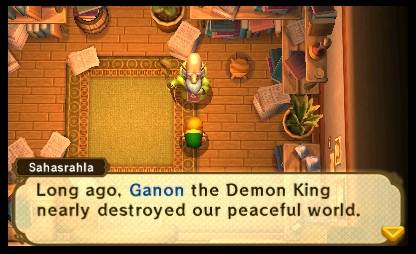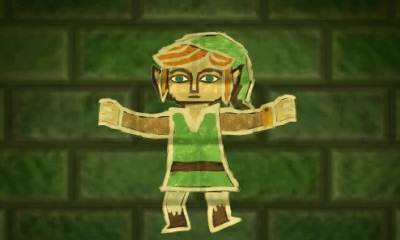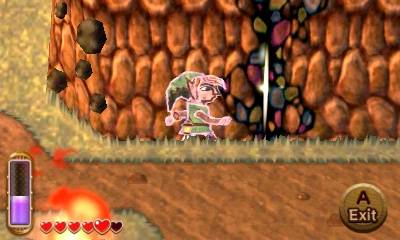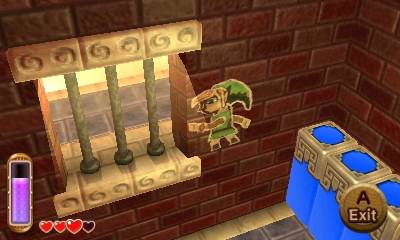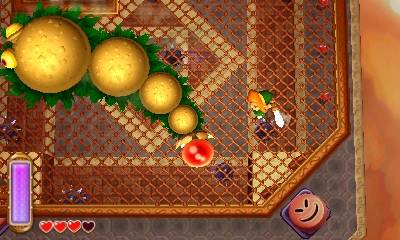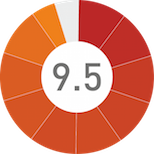
In recent years, the Zelda games have lost the plot. I am not going to say that recent Zelda games have been outright bad (although Spirit Tracks came very close), but they haven’t been the top notch, standard setting, epic odysseys that the series became synonymous with back in the day. Probably a large part of this has to do with a reluctance to move away from the formula the series established nearly two decades ago, and one which has so faithfully served it for all these years. Another part has to do with the fact that when the developers do decide to switch things up, their ‘progressive’ design decisions are, well, questionable at best.
Whatever the reason, the series has lost its shine and its luster in recent years. The newest original entry is The Legend of Zelda: A Link Between Worlds, a new top down Zelda adventure developed exclusively for the Nintendo 3DS, one that channels heavily, and acts as a sequel to, The Legend of Zelda: A Link to the Past, the SNES Zelda entry that is widely acknowledged to be the best game in the series, and even the greatest game ever made.
"It's not the most original or groundbreaking plot. It's mostly serviceable, and it very heavily mirrors the story in A Link to the Past. "
Ironically, in sticking so close to the spirit of what made A Link to the Past (and the Zelda games that came before it) so good, A Link Between Worlds takes some bold steps forwards that, for the first time in over a decade, meaningfully progress the series. It also ends up being the freshest, fastest, most fun, and- dare I say it- best– Zelda game we have had in a very, very long time now.
The Legend of Zelda: A Link Between Worlds serves as a sequel to the 1992 Link to the Past. Several generations after the cataclysmic events of that title, peace returned to Hyrule, and everything was okay, until a wizard called Yuga shows up. Yuga has the distinct ability to turn people into paintings, and he is planning on kidnapping the descendants of the Seven Sages from Ocarina of Time/A Link to the Past to revive Ganon and take over not just Hyrule, but its parallel dimension Lorule, entirely.
It’s not the most original or groundbreaking plot. It’s mostly serviceable, and it very heavily mirrors the story in A Link to the Past. The beginning is also distinctly low key, with none of the epic, mood setting, somber atmosphere of A Link to the Past’s dark, oppressive proceedings, and a bit more whimsy and light heartedness to the proceedings.
But any ideas that Nintendo dumbed the story down for kids go right out the window once the inevitable happens, and the real machinations behind the story are revealed. It’s still not a great narrative (although it has a surprisingly touching ending), but it’s a good one, one that gives you enough context for why you are doing what you are doing, and moves you from place to place to get things done.
"No longer are you interrupted every five minutes by some vague tangential plot thread that breaks the flow of the game. No longer does the game stop and spell problems out for you, so you know exactly what to do."
Perhaps the best thing about the story- and this is true for the entire game- is how fast it moves. People who sat through the nearly six hour long tutorials of Twilight Princess and Skyward Sword will be delighted to know that the game starts, and within twenty minutes, you’re just thrown into Hyrule with your sword, on your way to conquer the ancient temples that litter the land.
No longer are you interrupted every five minutes by some vague tangential plot thread that breaks the flow of the game. No longer does the game stop and spell problems out for you, so you know exactly what to do. It throws you into the world, old school style, and expects you to figure things out for yourself, like an adult. Walk around, explore, try to figure things out yourself.
This extremely fast pace, coupled with the lack of hand holding and tutorials, is further enhanced by what is probably the biggest departure from formula the series has made since 1998’s Ocarina of Time (but is, after all is said and done, a return to a very promising past): A Link Between Worlds is fully open world. Gone is the traditional structure of finding items in dungeons, clearing the dungeons with said items, and then only ever using those items to reach one or two odd places in the overworld that were otherwise inaccessible (but still gated): A Link Between Worlds gives you access to each and every item in its arsenal right from the get go. The impact this has on the game design, structure, and progression cannot be understated.
The full world is open right from the beginning, and you are free to go wherever you want, whenever you want, with very little exceptions. If you want to just take your time to explore the world, you are free to do that. If you get stuck in a specific dungeon, you can just exit it, and try to go finish another dungeon, because yes, you can clear dungeons in any order that you want now too.
"As fast moving and open as the rest of the game is, the dungeons are even more so: freed from the shackles of adhering to assumptions of specific items that a player is expected to have, every room in every dungeon shines in A Link Between Worlds."
The game achieves this by having an item rental shop available to you very early on in the game, where you can rent any item you want to for a price. There are no limits to how many items you can rent (although the fee, at least in the beginning, is a bit steep), except for one stipulation: if you die, you lose all your rented items, and must go back and rent them again.
This adds a nice risk/reward function to Zelda games (which, until now, had lacked any penalty for dying), although after a little while, the option to buy the items outright and own them becomes available, which removes the fear of dying and losing them. The fee for buying them is pretty high, but the game does have plenty of rupees available all over, so you’re never found wanting for any money.
As fast moving and open as the rest of the game is, the dungeons are even more so: freed from the shackles of adhering to assumptions of specific items that a player is expected to have, every room in every dungeon shines in A Link Between Worlds. These are masterfully crafted, sprawling, brain teasing, compact temples where every room teases the player, and demands that you figure out the solution to the problem yourself (no more Fi giving away the solutions). The solution is aways there, always completely accessible with the range of items that you have, you just have to think about it.
"As for the enemies and bosses themselves, they function as well as you would expect in a top down perspective. Some of them make use of some great strategies, but generally, it all boils down to dodging their blows, using the one item or technique that you need to to access their weak point, and then spamming B to attack."
And you’ll have to think, at least in the beginning, because of one wrinkle that the game throws in into its design: Link gets the ability to merge with walls and become a sort of wall paining. When he is merged with a wall, he can move left and right along the X axis and access places that would otherwise have been completely inaccessible to him. What sounds like a gimmick when described like that turns out to be possibly the best new mechanic Zelda has introduced since the Light and Dark Worlds in A Link to the Past.
An entirely new dimension is added to the game, and you are forced to stop, rethink, and re-evaluate your perspective based on not just the traditional planes of movement, but also a third axis. When the game joins its wall mechanic with its devious dungeon design, it can get outright diabolical. Enemies and bosses be damned, the real enemy in A Link Between Worlds are the dungeons themselves.
As for the enemies and bosses themselves, they function as well as you would expect in a top down perspective. Some of them make use of some great strategies, but generally, it all boils down to dodging their blows, using the one item or technique that you need to to access their weak point, and then spamming B to attack. The bosses themselves are variable, with some of them being really great, while others are a bit more forgettable and disappointing.
A Link Between Worlds looks beautiful, especially on the 3DS screen. Screenshots do not do it justice, it looks like A Link to the Past realized in 3D. While the graphics begin to look a bit more hideous when the game zooms in for some of its more cinematic cutscenes, on the whole, it’s a charming, beautiful game, one that moves at a blistering 60 frames per second, adding the kind of speed that Zelda has not known since the release of the original Link to the Past.
"The game makes excellent use of the 3D, not just to visual effect, but also within its gameplay, by integrating verticality and the general Z axis tightly into its game design."
The few issues with the graphics- basically the character models that don’t hold up in zoomed in cutscenes- are all easily forgiveable when this game’s use of 3D is considered. This is the rare 3DS game (only the third, in my estimation) that simply must be played with 3D on and at max. The game makes excellent use of the 3D, not just to visual effect, but also within its gameplay, by integrating verticality and the general Z axis tightly into its game design. It’s ironic that this game comes so closely after Nintendo released the 2DS, the neutered 3DS model without any 3D capability, because this game acts as the showcase for the kind of things you can achieve within game design with stereoscopic 3D.
And while A Link Between Worlds looks good, its possibly in the sound design that it completely trumps everything else. The Zelda series is known for having incredible soundtracks, soundtracks that have become fully embedded in pop culture. Somehow, A Link Between Worlds has a soundtrack that is possibly the best in the series yet.
The remixes of the old tunes are incredibly well done, with the new additions being extremely atmospheric and great additions to the canon as well. The first time you hear the fully orchestrated Zelda overworld theme, or the title screen music, you will understand.
"A Link Between Worlds nails it. It is a glorious, daring link to the future."
In recent years, Nintendo, and the Zelda series in particular, have been accused of relying on their past too much, tugging on nostalgia to try and sell their newer products which obviously don’t live up to the standard they are trying to evoke. At first glance, A Link Between Worlds looks like yet another cynical cash grab trying to exploit nostalgia for one of the greatest games ever made. But when you play it, you understand: Nintendo might be using the skin of an old classic to sell this new game, but this game is a bold step forward for them, and for the franchise.
This is the first Nintendo game in over a decade that challenges the player to think for him or herself, a game that maximizes player agency, a game that treats you like a thinking, fully functional adult, a game that is all about immaculate game design first, a game that moves briskly, with nothing holding it back, a game that still finds the time to tell a great story, a game with great graphics and great music. In recent years, Nintendo has done a lot that has been wrong. Not this time. A Link Between Worlds nails it. It is a glorious, daring link to the future.
This game was reviewed on the Nintendo 3DS.
Incredible dungeon design; full open world completely changes game progression, and lets you play the game the way you want to; the lack of tutorials or handholding; adventuring and exploring is a joy; the wall Link mechanic is a stroke of genius; incredible soundtrack; charming graphics, with ingenious use of 3D and full 60FPS; brisk pace, with the game somehow finding the time to tell a (surprisingly touching) story
Boss battles can be a bit hit or miss









